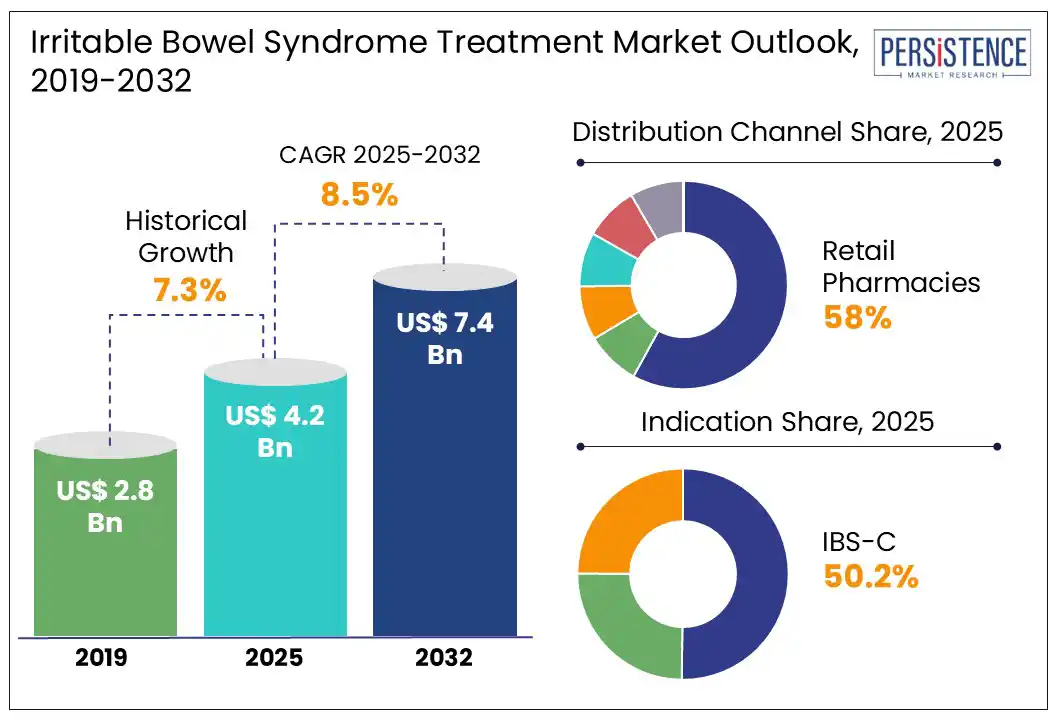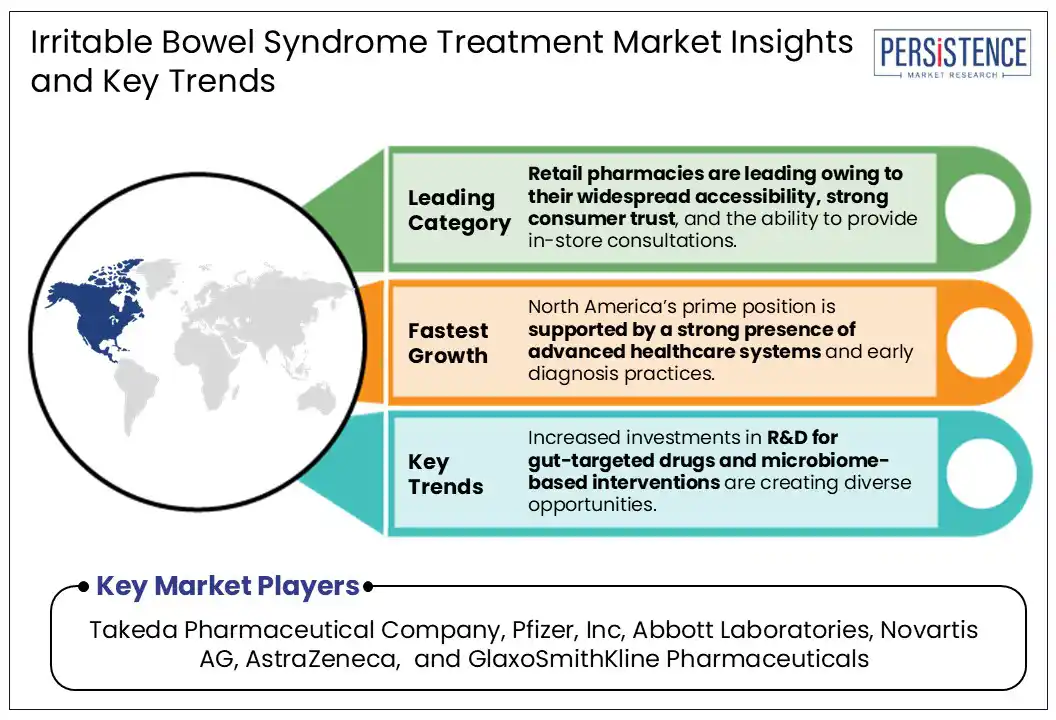ID: PMRREP9938| 192 Pages | 10 Jul 2025 | Format: PDF, Excel, PPT* | Healthcare

The global irritable bowel syndrome treatment market size is likely to be valued at US$ 4.2 Bn in 2025 and is estimated to reach US$ 7.4 Bn in 2032, at a CAGR of 8.5% during the forecast period from 2025 to 2032.
The irritable bowel syndrome treatment market growth is driven by an increasing prevalence of the disease worldwide, heightened patient awareness, and ongoing advancements in gastrointestinal therapeutics.
Irritable bowel syndrome (IBS) is a common gastrointestinal disorder characterized by chronic abdominal discomfort, bloating, and irregular bowel habits. According to the International Foundation for Gastrointestinal Disorders (IFFGD), IBS affects around 5-10% of the global population, with most people under the age of 50. This condition often leads to significant physical and emotional distress, even though there are no visible structural abnormalities. While its exact cause remains unclear, the development of IBS can be caused by gut-brain axis dysfunction, altered gut motility, food intolerances, and heightened sensitivity to stress.

Key Industry Highlights:
|
Global Market Attribute |
Key Insights |
|
Irritable Bowel Syndrome Treatment Market Size (2025E) |
US$ 4.2 Bn |
|
Market Value Forecast (2032F) |
US$ 7.4 Bn |
|
Projected Growth (CAGR 2025 to 2032) |
8.5% |
|
Historical Market Growth (CAGR 2019 to 2024) |
7.3% |
The irritable bowel syndrome treatment market is primarily driven by the growing adoption of disease-specific medications such as linaclotide and rifaximin. This trend is supported by improved healthcare infrastructure and expanded access to diagnostic tools in countries across North America and Asia Pacific. As patients and physicians increasingly prefer targeted drug therapies over traditional symptomatic treatments, the demand for advanced IBS medications is expected to witness continuous rise. Concurrently, the integration of digital health platforms, such as gut health tracking apps, allows for personalized symptom monitoring and encourages early adoption of prescription therapies.
Despite advancements, treatment costs for novel IBS therapies remain high, emerging as a significant barrier in the growth trajectory of the irritable bowel syndrome treatment market. A large percentage of patients in emerging economies struggle with drug affordability, while an underdeveloped insurance ecosystem further limits access to IBS medications. Furthermore, healthcare providers may be hesitant to prescribe high-priced targeted drugs without proven long-term outcomes, which can dampen overall market penetration and slow down growth.
Increased R&D activities by established pharmaceutical companies and emerging biotech firms present a key growth opportunity in the IBS treatment market. Pharmaceutical companies are aggressively pursuing novel therapies that target mechanisms such as gut-brain interaction, microbiome-based treatments, and combination regimens. Recent milestones include the launch of U.S. clinical trials for microbiome-targeted drugs aimed at reducing inflammation and improving gut motility. Another important development in this context is the advancement of new formulations such as extended-release linaclotide to enhance patient adherence and symptom control. Next-generation IBS medications present excellent avenues for stakeholders to meet the unmet needs of patients and offer effective treatment options.
Based on distribution channel, the retail pharmacies are likely to account for 58% market share over the forecast period owing to their widespread accessibility, strong consumer trust, and the ability to provide personalized in-store consultations. For chronic conditions such as irritable bowel syndrome, retail pharmacies serve as the primary point of access for commonly prescribed treatments, including antidiarrheal, laxatives, and neuromodulators. These outlets are especially critical in Tier 2 and Tier 3 cities where specialized healthcare facilities may be limited.
By indication, the irritable bowel syndrome treatment market segments include irritable bowel syndrome with constipation (IBS-C), irritable bowel syndrome with diarrhea (IBS-D), and irritable bowel syndrome with alternating constipation and diarrhea. With a share of 50.2%, the IBS-C segment is expected to dominate this category over the forecast period, propelled by increasing diagnosis rates and growing patient awareness of chronic constipation as a treatable bowel disorder. Furthermore, promising pharmaceutical innovations, such as the formulation of linaclotide and lubiprostone are leading prescription trends. These drugs work by improving intestinal fluid secretion and motility, offering consistent relief.

North America is expected to lead the irritable bowel syndrome treatment market in 2025, accounting for around 38.2% of global revenue. The region’s prime position is supported by a strong presence of advanced healthcare systems, widespread awareness, and early diagnosis practices. The region has also seen a steady rise in the use of targeted therapies, such as rifaximin and linaclotide, indicating a shift toward more personalized treatment options. These developments have enabled North America to maintain its position as a top market for IBS medications and innovation.
The irritable bowel syndrome treatment market in Asia Pacific is anticipated to witness the fastest growth in 2025. Factors fueling the regional market include urban lifestyle changes, growing awareness of gastrointestinal health, and expanding access to healthcare services. Countries such as India, China, and Japan are experiencing a surge in demand for both pharmaceutical and non-pharmaceutical solutions for IBS. A prominent trend emerging in this region is the increasing use of gut-targeted therapies, including probiotics and dietary interventions, alongside conventional drugs. Increasing healthcare investments and a growing focus on digestive wellness are expected to further accelerate the adoption of irritable bowel syndrome treatments across Asia Pacific in the coming years.
The global irritable bowel syndrome treatment market is marked by intense competition, with leading players driving advancements in IBS-C and IBS-D therapies. Companies are investing in targeted drug development, strategic collaborations, and the integration of digital health tools to enhance treatment outcomes and patient engagement. The growing popularity of probiotics, microbiome therapies, and gut-brain axis modulators is further shaping the competitive dynamics of the IBS treatment market.
The market is projected to reach US$ 4.2 Bn in 2025.
Rising adoption of targeted therapies and digital diagnostics is the key market driver.
The market is poised to witness a CAGR of 8.5% from 2025 to 2032.
Intensified R&D efforts by key players are expected to drive innovation in the IBS treatment market.
The Key Players in the Global Irritable Bowel Syndrome Treatment Market include Takeda Pharmaceutical Company, Pfizer, Inc., and Abbott Laboratories.
|
Report Attribute |
Details |
|
Historical Data/Actuals |
2019 - 2024 |
|
Forecast Period |
2025 - 2032 |
|
Market Analysis Units |
Value: US$ Bn |
|
Geographical Coverage |
|
|
Segmental Coverage |
|
|
Competitive Analysis |
|
|
Report Highlights |
|
|
Customization and Pricing |
Available upon request |
By Product
By Indication
By Distribution Channel
By Region
Delivery Timelines
For more information on this report and its delivery timelines please get in touch with our sales team.
About Author